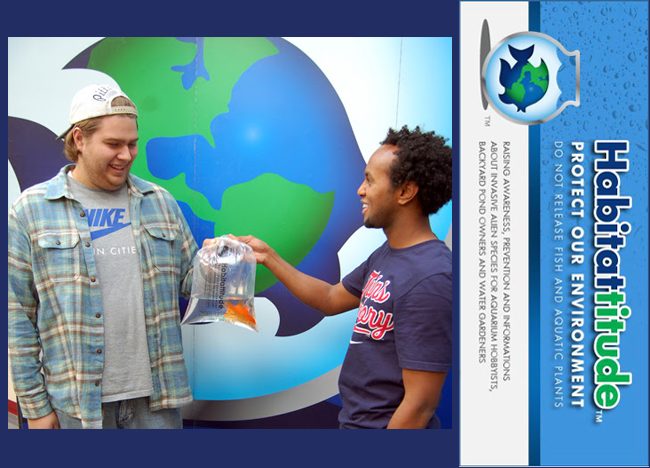Contacts:
Dave White, New York Sea Grant, E: dgw9@cornell.edu, P: 315.312.3042
Helen Domske, NY Sea Grant's Coastal Education Specialist, E: hmd4@cornell.edu, P: 716.645.3610
Brittney Rogers, NYSG Extension Aide, E: blr93@cornell.edu, P: 315.331.8415
Oswego, NY, May 9, 2016 - Last week in Toledo, Ohio, Cameron Davis, Senior Advisor for the U.S. Environmental Protection Agency (EPA), announced the newest projects being funded by EPA through the Great Lakes Restoration Initiative.
Among the 28 projects worth over $12.5 million, 15 tackle invasive species. One of these new national investments is supporting a Great Lakes Sea Grant Network effort to work with multiple partners, including "aquarists," water gardeners, educators and anglers, to prevent the spread of aquatic invasive species in the region. The University of Minnesota Regents will handle the $500,000 in funding through the University’s Sea Grant Program in Duluth.
“The last six years of work leading up to this new project is paying off with a shift in people’s willingness to clean their boats and keep their pets and plants from escaping into the environment," says Doug Jensen, Minnesota Sea Grant's Aquatic Invasive Species Program Coordinator. "During the next two years, thanks to the Great Lakes Restoration Initiative, we expect to continue the momentum and the trend."
According to Minnesota Sea Grant, prevention messages supported by the Stop Aquatic Hitchhikers!TM and HabitattitudeTM campaigns have 40 percent more people finding new homes for unwanted pet fish and plants, and cleaning off their boats since 2006.

Over the next two years, the Great Lakes Sea Grant Network, led by Minnesota, will create a regional collaborative to support surrender events where people can give up unwanted fish. The Minnesota Aquarium Society and Minnesota Sea Grant hosted their first-ever surrender event in January near Minneapolis, Minn., helping to re-home over 100 fish.
The Network also plans to use project funds to host a symposium in Milwaukee, Wisc., to discuss ways of improving the surrender events and to share research concerning aquatic invaders that spread due to releases and escapes.
As part of the two-year endeavor, the Sea Grant programs in Minnesota, New York, Pennsylvania and Wisconsin will be particularly active with 6-12 grade educators, working on developing and sharing lessons about the escape or release of unwanted pets and study specimens. Sea Grant will also be continuing the Stop Aquatic Hitchhiker’s messaging to boaters and anglers, encouraging them to clean their boats and recreational equipment before reuse and to not dump unwanted bait into lakes and rivers.
"To protect our waters for the enjoyment of future generations, we need to continue our successes," says Jensen. "We've found that once people understand the threats and consequences, what to do and why, they very likely will do it."
NYSG's Recreation/Tourism Specialist Dave White, based at the State University of New York at Oswego, says that "The clean, drain and dry campaign continues to move forward to ensure that boaters and others are not moving an invasive species from one body of water to an additional one they might be enjoying throughout the course of the day."
"One thing people should be aware of is that several new local and state regulations have been put in place requiring folks to remove all plant and animal products from their boats," which White reminds includes kayaks and other recreational vehicles. "So in addition to clean, drain and dry there are now body of water specific regulations that boaters and other users should be aware of."
Since 2008, NYSG has educated over 650,000 boaters on how to be environmentally-friendly, safe and legal on the state's waters with its "Discover Clean and Safe Boating" exhibit. The informative panels and maps of our "Great Shipwrecks of NY¹s 'Great' Lakes" traveling exhibit, which has made over a half-dozen stops in three years, has reaches over 750,000 people total in New York, Pennsylvania and Vermont. More at www.nyseagrant.org/marina, www.nyseagrant.org/shipwreck.
More Info: New York Sea Grant
New York Sea Grant (NYSG), a cooperative program of Cornell University
and the State University of New York, is one of 33 university-based
programs under the National Sea Grant College Program (NSGCP) of the
National Oceanic and Atmospheric Administration (NOAA). The NSGCP
engages this network of the nation’s top universities in conducting
scientific research, education, training and extension projects designed
to foster science-based decisions about the use and conservation of our
aquatic resources. Through its statewide network of integrated
services, NYSG has been promoting coastal vitality, environmental
sustainability, and citizen awareness about the State’s marine and Great
Lakes resources since 1971.
New York Sea Grant maintains Great Lakes offices at SUNY Buffalo, the
Wayne County Cooperative Extension office in Newark and at SUNY Oswego.
In the State's marine waters, NYSG has offices at Stony Brook University
and Stony Brook Manhattan, in the Hudson Valley through Cooperative
Extension in Kingston and at Brooklyn College.
For updates on Sea Grant activities: www.nyseagrant.org has RSS, Facebook, Twitter, and YouTube links. NYSG also offers a free e-list sign up via www.nyseagrant.org/coastlines for its flagship publication, NY Coastlines/Currents, which is published several times a year.